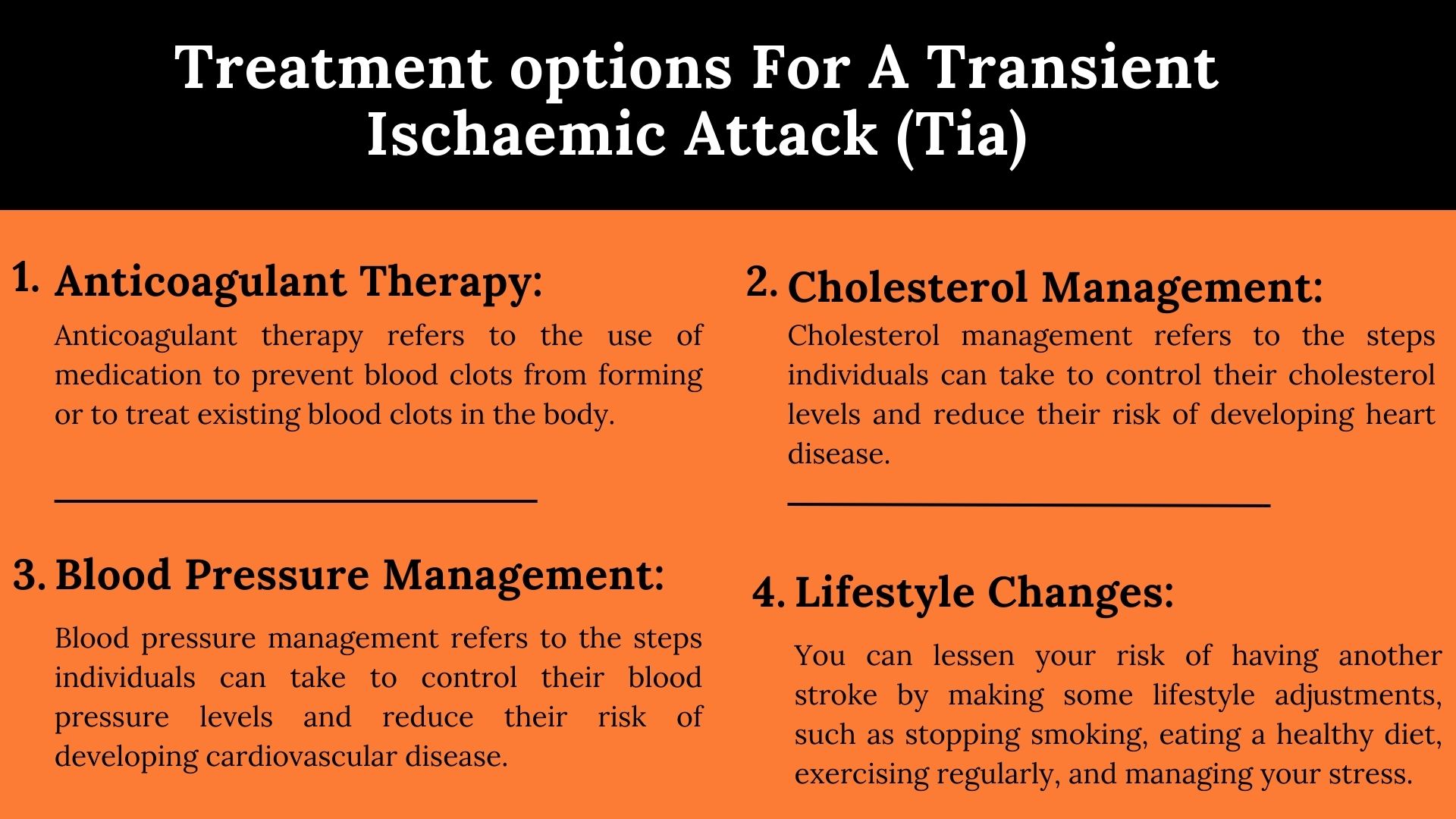
Introduction
Transient Ischaemic Attack, commonly referred to as TIA or “mini-stroke,” is a condition that can cause temporary symptoms similar to those of a stroke.
While the symptoms may only last for a short period, TIA is a serious medical emergency that requires immediate attention. TIA occurs when blood flow to the brain is disrupted, usually due to a blood clot or narrowing of the blood vessels.
It is a warning sign that the person is at a high risk of having a full-blown stroke in the future, which can result in permanent brain damage or even death.
In this article, we will discuss the causes, symptoms, diagnosis, treatment, and prevention of the Transient Ischaemic Attack to help you better understand this condition and take the necessary steps to protect yourself from this condition.
Some of The Main Symptoms of a Transient Ischaemic Attack (Tia)
- Complete paralysis of one side of the body.
- Sudden loss of vision.
- Blurred vision.
- Double vision.
- Sickness.
- Dizziness.
- Confusion.
- Balance and coordination issues.
- And difficulty swallowing (dysphagia).
When To Seek Medical Attention
During the initial stages of a transient ischaemic attack, it is impossible to distinguish between a TIA and a full stroke.
Patients are usually given aspirin right away if a transient ischaemic attack is suspected. This aids in stroke prevention.
After that, patients still need to be evaluated in a hospital. Within 24 hours of the onset of symptoms, patients should be referred to a specialist.
Doctors can use an assessment to figure out the best way to lower that risk. In such cases, patients are advised to make an urgent appointment with a general practitioner as they can decide whether to send them to the hospital for an evaluation.
How Do Doctors Confirm a TIA?
Doctors typically use a combination of methods to confirm a TIA (Transient Ischemic Attack).
Some common methods used by doctors to diagnose this problem typically include:
- Physical Examination: Doctors usually perform a physical examination to look for signs of neurological deficits or other symptoms that may suggest a TIA.
- Medical History: Doctors also ask about the patient’s medical history, including any past incidents of TIA or stroke, as well as any risk factors for these conditions, such as high blood pressure, high cholesterol, smoking, or diabetes.
- Imaging Tests: Imaging tests such as CT scans, MRI scans, or Doppler ultrasounds might also be used to look for a clot or other blockage in the blood vessels of the brain.
- Blood Tests: Blood tests may be carried out to look for signs of a clotting disorder or other underlying medical problems that could increase the risk of TIA or stroke.
The combination of these diagnostic methods can certainly help doctors confirm the presence of a TIA and determine the appropriate treatment plan for the patient.
Causes Of A Transient Ischaemic Attack (Tia)
One of the blood vessels that supply oxygen-rich blood to the brain becomes blocked during a TIA. However, pieces of fatty material or air bubbles can also cause this blockage.
A blood clot that has formed elsewhere in your body and traveled to the blood vessels that supply the brain is the most common Transient Ischaemic Attack.
The following factors can increase your risk of having a TIA:
Smoking, obesity, hypertension, high cholesterol levels regularly, excessive alcohol consumption, atrial fibrillation, and diabetes. Moreover, people of Asian, African, or Caribbean descent are associated with an increased risk of having a TIA.
Treatment For A Transient Ischaemic Attack (Tia)
Even though the symptoms of a Transient ischaemic attack go away in a few minutes or hours, you will still need treatment to prevent a second TIA or a full stroke.
Factors such as age and medical history generally determine the type of treatment. There are various treatments available in order to treat this condition. The primary goal of treating a TIA is to prevent a subsequent stroke.
Treatment options may include:
Anticoagulant Therapy
Anticoagulant medications, such as warfarin or dabigatran, may be prescribed to prevent blood clots from forming in the heart or other parts of the body that can travel to the brain.
Blood Pressure Management
If you have high blood pressure, your doctor may recommend medications to help lower it, as this can help reduce the risk of a stroke.
Cholesterol Management
High cholesterol levels can contribute to the development of atherosclerosis, which can lead to TIAs and strokes. Your doctor may prescribe medications to help lower your cholesterol levels.
Lifestyle Changes
Certain lifestyle changes, such as quitting smoking, eating a healthy diet, getting regular exercise, and managing stress, can also help reduce your likelihood of a subsequent stroke.

Preventing a Transient Ischaemic Attack (TIA)
A Transient Ischaemic Attack is frequently a warning sign that another may follow, putting you at risk for a full, potentially fatal stroke soon.
There are several ways to lower your risk of having a Transient Ischaemic Attack or stroke in the future, regardless of whether you have previously experienced it or not.
These are some:
- Maintaining a healthy weight
- Eating a well-balanced diet
- Exercising frequently
- Restraining from tobacco
FAQs
Is a Transient Ischaemic Attack Serious?
Transient Ischaemic Attack (TIA) is a serious medical condition that requires immediate medical intervention.
A TIA occurs when there is a temporary disruption of blood flow to the brain, which can cause symptoms similar to a stroke, such as numbness, weakness, or tingling on one side of the body, difficulty speaking or understanding speech, vision problems, and loss of coordination or balance.
Although the symptoms of a TIA typically go away on their own within a few minutes to a few hours, it is still important to seek immediate medical attention because a TIA can indicate a more severe stroke that might occur in the future.
How Long Will a Tia Last?
The symptoms of a TIA typically last only a few minutes to a few hours, with most lasting less than an hour. However, some symptoms can also last longer, up to 24 hours in rare cases.
It is important to seek immediate medical attention if you suspect you or someone else is having this attack, as it can indicate a more severe stroke in the future.
Treatment for a TIA involves identifying the underlying cause and managing any risk factors to prevent future TIAs or strokes.